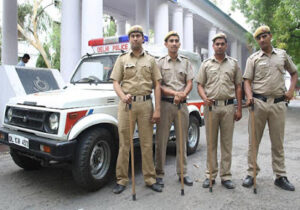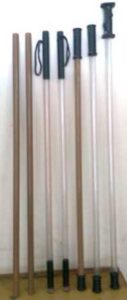For once, I will not describe the convoluted threads of thought that caused to research “Lathi”. Many definitions of Lathi have it as a bamboo stick of about five foot length, often with the ends bound with metal. Lathi actually means “stick” and the examples that seem to have been used by Indian police in more recent years seem to be shorter. Readers of previous blog posts may be recall my post on HG Lang’s book on Walking Stick defence, based on Vigny’s La Canne techniques. Lang’s recommendation was a light walking cane of malacca or ash root. It used velocity and fast manipulation by the wrist for effect rather than weight. Lang was an officer in India and mentions that some police forces there had shown interest in the ideas. Possibly the switch to shorter lathis for police use was influenced by this.
What is of particular interest is that the bamboo lathi seems to be being phased out. This article here sets the scene.

The upshot of this is that if you google “lathi” you will get a large number of hits offering you the plastic replacement. The suppliers, who are keen to sell these, call them “lathi”. I note that the article above seems to avoid calling the new version a lathi. “Lathi-charge” has similar connotations to terms like “baton round” in some other countries so I can see the Indian police might want to disassociate from the term.
Because so many companies are keen to market “lathi-replacements” gathering some data about the items was much less of a task than much of my research.

The sticks are about a metre long and 25 mm external diameter. They are made of polycarbonate. On one end is a 6" handle with a thumb loop ("wrist loop" is a misnomer for batons!). One site describes this as “mock-leather” so it is probably some form of rubber-like polymer. On the other end is a 4” cap, apparently of similar material. Surprisingly, the sticks are actually tubes! Internal diameter is given as 17 mm or 19 mm, giving wall thicknesses of 3 or 4 mm. One site gives the weight as around 350 g/12 oz. Sticks/ canes are available in black, khaki and clear.
One question that occurs to me is why such a subdued choice of colours? I think the police are missing a few good tricks here. Suppose we have “cop canes” in a nicely visible light blue? You do not even need to cast them in a new colour of polycarbonate. Pour a cup full of paint down a clear tube, pour it out again and you have your blue cane.
In “Kill or Get Killed” Rex Applegate talks of the psychological effect on a mob of being confronted with an obviously disciplined force with “white baton, white helmet and white gloves”. Highly visible metre-long blue batons would have the same effect. Blue batons would make officers more visible, useful when operating with police helicopters. Waving a blue cane above your head will alert comrades and civilians to the location of an officer. The highly visible cane has obvious applications for directing traffic or civilians. Held in two hands it can be used as a barrier to keep crowds back. Doubtless we will soon see a vocabulary of signals that can be made with the baton, useful when radio communication is not practical.
What is not apparent in the above article is whether these polycarbonate canes will just be issued for riots or will be carried routinely when on the beat. Personally I think the latter is the better option, at least for cops that walk beats rather than ride in cars. Police actually walking the streets seems to be on the decline in many cities. I think this is a mistake. Patrol cars are good for responding to crimes and traffic enforcement. Patrolling on foot detects and deters crime and other anti-social acts.
A long cane will be a great asset for a cop walking a beat. Firstly, it serves as a walking cane, and is useful if the ground is slippery. A cane will generally be carried in hand rather than worn on a belt or in a pocket. This means it can be rapidly brought into action should a sudden threat arise. The length of a cane gives an advantage against attacks from weapons such as knives or bottles. The officer has a chance to disable an attacker before he can close distance. The length of the cane allows the officer to strike targets such as the legs that would be difficult to reach with a truncheon or shorter baton. A cane is sufficiently light enough that the officer can still carry a PR24, flashlight or other impact weapons in addition to the cane.

How to use a “police cane”? Given the light weight of these canes HG Lang’s book and techniques are the obvious starting point. Lang describes strikes to the head, throat and chin but primary targets for police use will be the limbs, it being understood that in this context this includes the trapezius and clavicle regions. The reach of the cane allows a fast painful strike to be snapped into the leg, arm or hand, as required. For closer ranges some of the techniques in my book such as the bumper method can be used. The rubber-like caps at either end of the cane allow thrusting and striking techniques with the ends with less risk of excessive damage. A variety of locks and restraining moves can be made with a metre long cane. I detail the principles behind these in my book. For a wealth of examples consult “Stick Fighting” by Masaaki Hatsumi. The FBI Baton manual and the baton and long baton sections of “Kill or Get Killed” are also worth a view.

The tubular construction of the cane offers some interesting possibilities. If the canes prove to be too light a second, smaller tube or other material can be inserted inside to increase the weight. A small diameter flashlight, inserted in the handle end would turn the can into a metre long lightstick: which would make it look like the police are armed with lightsabres!
The police cane has much to recommend it. Having such devices “readily to hand” may mean less recourse to more lethal defensive measures.